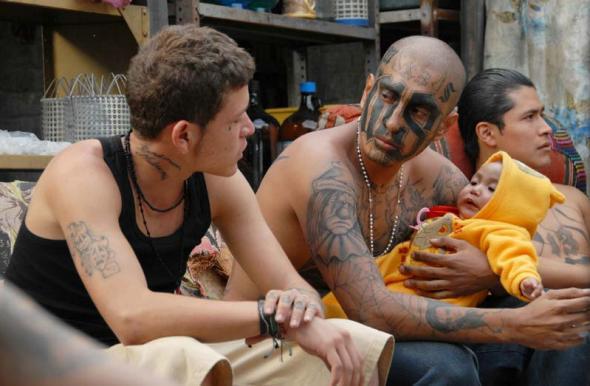Television, it’s often said, is a writer’s medium. Audiences have gotten used to crediting creators and showrunners like David Simon, Matthew Weiner, and Jenji Kohan as the creative visionaries behind their shows, while directors are still more often thought of as hired guns, brought in for an episode or two, their contributions relatively short-lived.
True Detective, though perhaps primarily the creation of its writer—novelist Nic Pizzolatto—is an exception: Every episode of its soon-to-be-completed first season is directed by Cary Fukunaga. The 36-year-old filmmaker deserves credit for the show’s distinctive visual style, coaxing some incredible performances out of Matthew McConaughey and Woody Harrelson, and a few feats of virtuoso filmmaking as well—notably a riveting six-minute scene, filmed in one uninterrupted take, that follows McConaughey’s character through a pitched gun battle in a suburban housing project.
Those who have seen Fukunaga’s first film, the highly acclaimed Sin Nombre, are not surprised by the director’s bravura work on the HBO series. On paper, the two works seem to have little in common. True Detective is a southern gothic murder mystery involving multiple overlapping timelines, unreliable narrators, heady-to-the-point-of-parody philosophical dialogue, and references to obscure 19th-century fiction. Sin Nombre, which Fukunaga wrote as well as directed, is a fairly straightforward drama about two young Latin American migrants trying to reach the U.S. border. The dialogue, all in Spanish, is fairly prosaic throughout. (Fukunaga’s other major film was a decent 2011 adaptation of Jane Eyre starring Mia Wasikowska and Michael Fassbender. The guy’s not in much danger of being pigeonholed.)
On closer viewing, though, the two projects share more than you might think. Many of the qualities that make True Detective so addictive—as well its more frustrating tendencies—are also present in his first film.
Like, True Detective, Sin Nombre is a two-character story. Sayra, a Honduran teenager, reluctantly heads north with her father and brother, hoping to cross Mexico on top a freight train, then jump the U.S. border and go to live with her dad’s new family in New Jersey. Meanwhile, Willy, a member of the infamous Mara Salvatrucha gang in Chiapas, Mexico, becomes disillusioned with the life he’s chosen after his girlfriend is killed by local gang leader Lil Mago. The two meet while the gang is robbing the migrants on board the train: Willy saves Sayra from being raped by Lil Mago, and kills Lil Mago in the process. The two strike up a relationship, and later—after being separated from the train and Mayra’s skeptical family—make a run for the border together, while trying to evade Willy’s former Mara compatriots, who are bent on revenge.
Like True Detective, then, Sin Nombre is concerned with gangs, drugs, and stomach-churning violence (a Mara snitch is chopped up and fed to dogs in an early scene). It’s also, again like the HBO show, concerned with landscape: Fukunaga loves wide-open vistas—Louisiana Bayous, Central American forests, English moors—that, weirdly, feel almost claustrophobic with their implied menace. And while Sin Nombre isn’t as laden with symbolically important visual Easter eggs as True Detective is, it gives the distinct impression that Mara Salvatrucha—a real life pan-American criminal organization also called MS-13—is an invisible empire, making its presence known through graffitied threats on crumbling village walls, hand signals, and its members’ extensive tattoos. (Both Sin Nombre and True Detective feature terrifying villains with full-body tattoos so intricate and potentially significant that viewers may be tempted to pause the film for a better look.)
Then there are the weaknesses. Both projects share a troubling tendency to view poor, rural areas as Conradian Hearts of Darkness. Across the Rio Grande from the big-box stores of Southern Texas, or a few miles out of town from Martin Hart’s well-moved lawn, lies a world defined by corruption, anarchy, and man’s inhumanity toward man—or more precisely, toward woman.
Unfortunately, both projects also share a disconcertingly lascivious fixation on sexual violence. There are two female characters in Sin Nombre and both are threatened with rape within 10 minutes of each other. And anyone complaining that the female characters on the show feel like cardboard cutouts probably won’t be all that edified by Sayra, who, frankly, ranks as one of the dumbest protagonists I’ve seen in a recent dramatic film.
My colleague Willa Paskin has defended the portrayal of women on True Detective, arguing that it’s “about the horrible things that men do to women, things that usually go unseen and uninvestigated.” I think that’s a tougher case to make in the case of Sin Nombre, since it can be hard, at times, to say exactly what the movie is about.
Fukunaga defended himself—convincingly I think—from charges of “poverty porn.” But for a film with all the trappings of social realism, and which was said to involve extensive firsthand research, it doesn’t really impart much about immigration. We see little of the economic conditions that induced Ayra’s father to want to leave Honduras andthe movie makes illegally crossing the U.S. border look pretty easy. I certainly wouldn’t recommend it as a starting point for anyone looking to learn more about MS-13, an organization with a pretty fascinating history involving El Salvador’s civil war, the L.A. gang wars of the 1990s, the Clinton administration’s deportation policies, and Mexico’s current drug violence. None of that’s in the movie.
All that’s said, it’s still a pretty enjoyable movie, featuring crisp action scenes, a unique and vivid setting, and a few genuinely heartbreaking moments. Still, on a second viewing, it felt shallower than I—or most reviewers—gave it credit for when it came out.
With one episode left, I’m not ready to say the same of True Detective. I’m hopeful that the conclusion of the show will demonstrate that it’s done more than dress up the well-worn troubled-cops-chase-psychopath genre with exceptionally high production values and an inflated sense of self-importance.
Fukunaga’s certainly proven that he can keep viewers entranced. But it’s not quite clear yet that he knows what he’s trying to tell them.
